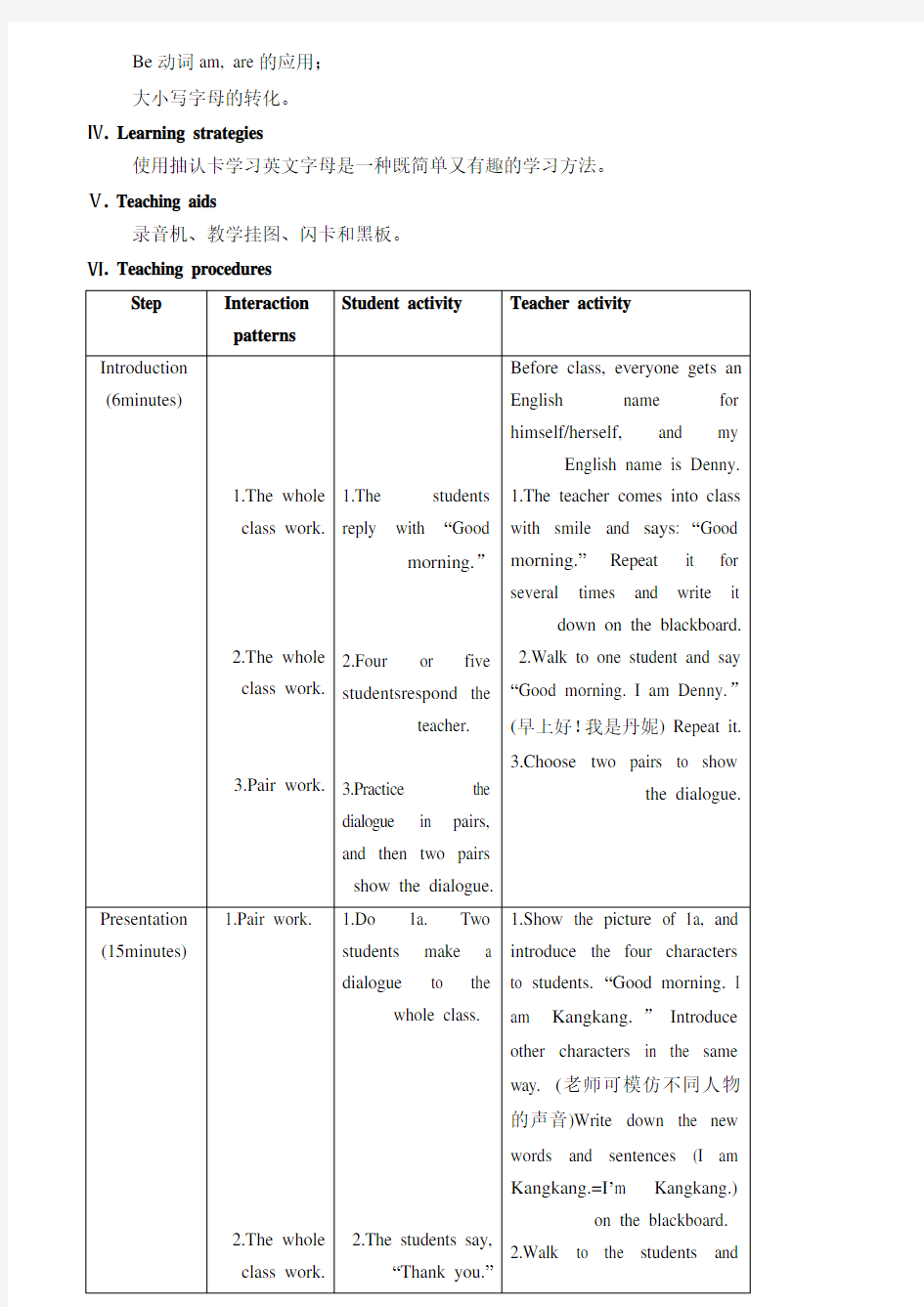2014年秋七年级上册仁爱英语教学案例设计


Unit 1 Making New Friends
Topic 1 Welcome to China!
Section A
Ⅰ. Material analysis
本课是初中阶段的第一节课。主要活动是1a, 2a和3a。通过中国的康康(Kangkang)在机场迎接从国外来的Michael, Jane和Maria, 学习有关问候、介绍、辨认他人、欢迎及感谢等表达方式;同时还将学习有关国家和城市的名称,如:China, the USA, the UK, Hong Kong, Beijing 等;另外,还将学习英文字母Aa~Gg。教师可采用师生互动、生生互动、游戏等教学方式;同时要关注学生的个性差异,发挥学生的积极性和主动性,为以后的英语学习创造一个好的开端。Ⅱ. Teaching aims
1. Knowledge aims
能够正确朗读并运用下列词汇:good, morning, I, am, welcome, China, thank, hello, are, yes, no 等;
能够熟练读写字母 Aa~Gg,并认识到字母有印刷体和书写体、大写和小写之分;
能够用英语熟练表达问候和介绍:Hello! / Hi! Welcome to China! Thank you. / Thanks. I am …/ I’m…Are you…?
2. Skill aims
能听懂有关问候、介绍、辨认他人、欢迎及感谢等的表达方式;
能运用表示问候、介绍、辨认他人、欢迎及感谢等的表达方式进行简单的交流;
能正确地朗读对话,并能注意语音语调;
能正确书写和使用大小写字母。
3. Emotional aims
能够与同学积极合作,参与课堂活动,大胆实践;
能够认真、规范书写英文字母和单词;
能够体会到英语学习的兴趣,养成良好的英语学习习惯。
Ⅲ. The key points and difficult points
1. Key points
正确使用表示问候、介绍、辨认他人、欢迎及感谢等的表达方法;
正确书写Aa~Gg大小写字母。
2. Difficult points
Be动词am, are的应用;
大小写字母的转化。
Ⅳ. Learning strategies
使用抽认卡学习英文字母是一种既简单又有趣的学习方法。Ⅴ. Teaching aids
录音机、教学挂图、闪卡和黑板。
Ⅵ. Teaching procedures
correctly with
less
time is the winner.
2.Assign homework :
Review
the
key
words
and expressions in Section A;
Make short dialogues orally;
Copy the new words for
five
times;
Preview Section B-1a.
Teaching reflection:
本节课通过利用教学挂图、班级活动、小组活动、结对活动等多种教学方式,充分调动学生的积极性和主动性,整个教学过程符合学生的认知规律,能够做到重点突出,难点突破。但是学生练的时间不够充分,在以后的教学中,应注重学生的活动。
Welcome to China!
Section A
1.Good morning. 4. —Are you …? China
2. —Welcome to China! —Yes, I am. / No, I ’m not the USA
—Thank you. / Thanks. 5. —I am …= I ’m … the UK 3. —Nice to meet you. 6. Hello! = Hi!
—Nice to meet you, too.
Section B
Ⅰ. Material analysis
通过上节课的学习,学生们已经初步了解了一些表达问候和介绍的英语知识。本课主要活动是1a 和3a 。通过Maria 和妈妈购物时偶遇Mr. Brown ,并向他们互相介绍展开学习,同时,掌握有关问候和介绍他人的表达方式:“Nice to see you!”,“How do you do?”,“This is …”。同学们继续学习字母Hh ~Nn 。老师采用多媒体及游戏的教学方式展开本节课的教学活动,把课堂交给学生,使学生真正成为课堂的主人。 Ⅱ. Teaching aims
1. Knowledge aims
能够正确朗读并运用下列词汇: see, this, is, my, teacher, how, do, mom, dad, Miss ; 能够熟练读写字母Hh ~Nn ,并认识到字母有印刷体和书写体、大写和小写之分;
能够用英语熟练表达问候和介绍他人:Nice to see you! How do you do? This is…
2. Skill aims
能听懂有关问候、介绍、辨认他人的表达方式;
能运用表示问候、介绍、辨认他人的表达方式进行简单的交流;
能正确地朗读对话,并能注意语音语调;
能正确书写和使用大小写字母。
3. Emotional aims
能够与同学积极合作,参与课堂活动,大胆实践;
能够认真,规范书写英文字母和单词;
能够有兴趣了解中外有关称谓的知识,并能在现实生活中积极实践。
Ⅲ. The key points and difficult points
1.Key points
正确使用表示问候、介绍他人的表达方法;
正确书写Hh~Nn大小写字母。
2. Difficult points
Be动词am, is, are的应用;
称呼语Miss, Mr, Ms的区别和使用;
大小写字母的转化。
Ⅳ. Learning strategies
做游戏是学习英语的一种好方法。
Ⅴ. Teaching aids
录音机、多媒体、闪卡和黑板。
Ⅵ. Teaching procedures
Ⅶ. Blackboard design
Welcome to China!
Section B
1. This is…see my
2. —Nice to see you. mom dad
—Nice to see you, too. teacher
3. —How do you do? Mr. Miss Ms.
—How do you do?
Section C
Ⅰ. Material analysis
本节课通过四组图画和对话呈现教学,主要活动是1a和2a。学生将在本课中进一步学习表示问候、道别、感谢的表达方式“Good afternoon.”,“How are you?”及其答语“Fine, thanks. I’m OK.”此外,还将完成26个英文字母的学习。本节课是一节读写课,教师在教学过程中,应该把重心放在对学生读写能力的培养上,加强学生语言运用能力的培养。
Ⅱ. Teaching aims
1. Knowledge aims
能够正确朗读并运用下列词汇: afternoon, goodbye, fine, and, here
能熟练读写字母Oo~Zz并认识到字母有印刷体和书写体,大写和小写之分;
能用英语表达有关问候和告别:How are you? Fine, thanks. And you? I’m OK. Goodbye. Here you are. Thank you.
⒉Skill aims
能听懂有关问候、道别、感谢等的表达方式;
能运用表示问候、道别、感谢等的表达方式进行简单的交流;
能在教师的指导下进行简单的角色表演;
能正确地朗读对话,并能注意语音语调;
能大声、准确地演唱英文字母歌;
能正确书写和使用大小写字母。
⒊Emotional aims
能够与同学积极合作,参与课堂活动,大胆实践;
能够认真、规范书写字母和单词;
能体会到学习英语的兴趣,培养学生良好的学习习惯。
Ⅲ. The key points and difficult points
1. Key points
正确使用表示问候、道别、感谢等的表达方式;
正确书写字母Oo~Zz和辨音。
2. Difficult points
Be动词am, is, are的应用;
大小写字母的转化;
含有相同音节的字母归类。
Ⅳ. Learning strategies
唱英语歌曲是学习英语的一种好方法。
Ⅴ. Teaching aids
录音机、多媒体、黑板和闪卡。
Ⅵ. Teaching procedures
Step Interaction
patterns
Student activity Teacher activity
Introduction (6minutes) 1.The whole
class
work.
2.The whole
class work.
3.Individual
work.
4.The whole
class work.
1.Students reply to the
teacher “ Hi! Good
morning!”
2.Respond the
teacher’s questions
one by one.
T: How do you do?
S: How do you do!
T: Welcome to …!
S: Thanks.
T: Nice to meet you.
S: Nice to meet you,
too.
3.Read the letters one
by one. The student
who can’t read it
correctly should sing a
song.
4. Do 3. Follow the
song and sing it twice.
1.Greet with students
using the
Expressions “Hello!
Good morning!”
2.Point out some
flashcards using the
key sentences in
Sections A&B and
make conversations
with students.
3.Play a game. The
teacher shows the
letter cards (the
letters from Aa~Nn)
one by one and
chooses students to
read it one by one.
4.Play the tape and
let students sing the
song The ABC Song for two times.
Presentation (15minutes)
1.Individual
work and the
whole class
work.
2.Individual
work and pair
work.
1.The student gives
the answer “How do
you do?”and “Thank
you./ Thanks.”;
The student responds,
“Fine, thanks. And
you?”The student
follows the teacher
and asks the teacher
“How are you?”; The
student answers, “I’m
OK.”
2.Do 1a. Students first
look at the pictures
and guess what the
pictures are about, and
then discuss the
1.Show a flashcard
with the sentence
“How do you do?” to
a student and ask
him/her to give the
answer. Give the
student who can give
the answer correctly
the card and say,
“Here you are.”
Walk to one student
and say, “Hello!
How are you?” Help
the student respond,
“Fine, thanks. And
you?” and continue
to say, “I’m OK.”
Show the flashcard
with “How are
you ?” on it and let
students follow it
twice; Walk to one
student and let
him/her to ask the
teacher “How are
you?”and answer,
“Fine, thanks. And
you?”
2. Show four pictures
in 1a to students. Let
students guess and
discuss the meaning
of the pictures in
meaning of the pictures in pairs; Four pairs share their ideas about the pictures with the
whole class; The students match the conversations with the pictures and check
the answers.
pairs;
Choose four pairs to talk about the four
pictures;
Write down the short conversations on the
blackboard.
Consolidation (8minutes) 1.Pair work. 1.Do 1b. Read 1a in
pairs and two pairs act
out the conversations
in pairs;
Make up new
conversations in pairs;
Share their
conversations with the
whole class.
1.Give students one
minute to read 1a in
pairs and choose two
pairs to act it out;
Let students make up
a new conversation
with the expressions
in 1a in pairs, if
necessary, they can
use the expressions
they learned in
Sections A & B;
Choose two pairs to
show their new
conversations.
Practice (10minutes) 1.The whole
class work.
1.Do 2a. Listen to the
teacher carefully,
observing the teacher’s
mouth. And imitate the
pronunciation;
Try to write down the
letters with correct
stroke order with book
closed; Then open the
books and self-check
their own spellings;
Follow the teacher to
trace the letters in the
1.Show the letter
cards from Oo to Zz
one by one and read
them with rising and
falling tones;
Ask students to write
them down with
correct stroke order;
Walk around the
classroom and check;
Then write down the
letters one by one
with correct stroke
2.Individual
work.
3.Individual
work.
4.The whole
class work.air with their hands
and read them.
2.Do 2b. Read the
letters aloud and do 2b
by themselves;
Listen and check the
answer.
3.Do 2c. Write down
the big or the small
letters.
4.Do 3. Students sing
the song and fill in the
blanks. Then sing the
song again together.
order while reading
them aloud.
2.Let students do 2b
first by themselves;
Play the tape and let
students check the
answer of 2b.
3.Show some words
we have learnt to
students and write
them down on the
blackboard.
4.Play the ABC song
and check the
answer.
Production (6minutes) 1.The whole
class work and
group work.
1.Sing the song and
follow the tape. Three
students come to the
blackboard and write
down the 26 letters in
order. The student
who writes most
quickly and best is the
winner.
1.Play the ABC
song. Have a letter
competition:
Choose three students
to come to the
blackboard and write
down the 26 letters
in order.
2. Assign homework:
Review the words and
expressions in
Section C;
Make up a new
conversation orally;
Write the letters
Aa~Zz on four-line
grid;
Copy the new words
for five times;
Sing the letters song;
Preview Section
D-Grammar and
Functions.
Teaching reflection:
本节课学生在做2b部分时,遇到了问题,对于相同音素掌握不牢,找
不准确,在以后的语音学习中老师应多加强学生这方面的训练。
Ⅶ. Blackboard design
Welcome to China!
Section C
1. —Here you are. 3. —Good afternoon.
—Thank you./ Thanks. —Good afternoon.
2. —How are you? 4. —Goodbye.
—Fine, thanks. And you? —Bye.
—I’m OK.
Section D
Ⅰ. Material analysis
本课是本话题的最后一课,主要是通过Grammar和Functions两部分来巩固Sections A~C 已学过的内容:be动词am, is, are的用法;表示问候、感谢、欢迎等功能句;26英语字母的书写及大小写的转换;最后通过Project 板块让学生制作并使用名片交友的活动综合运用本话题所学的知识,学会用英语做事情。本节课老师将采用多媒体教学,以培养学生的学习兴趣,辅助整节课的教学。
Ⅱ. Teaching aims
1. Knowledge aims
引导学生复习本话题Sections A~C的单词;
引导学生熟练读写26个英语字母及大小写;
引导学生总结be动词am, is, are的一般现在时在不同情况下形式的变化及am的缩写形式:I am Kangkang. = I’m Kangkang. This is Miss Wang.
—Are you …? —Yes, I am. / No, I’m not.
引导学生用英语表达问候、告别、感谢、欢迎、介绍及辨认他人等交际功能的基本表达法进行交流。
2. Skill aims
能听懂有关问候、告别、介绍等的表达方式;
能听懂简单的日常用语并作出适当的反应;
能运用表示问候、告别、介绍等的表达方式进行简单的交流;
能正确地朗读对话,并能注意语音语调;
能够在图片的帮助下进行阅读,理解大意,并按要求进行语言活动;
能正确书写字母和单词,并能用大小写字母对所学单词进行较自如的转换。
3. Emotional aims
能够与同学积极合作,参与课堂活动,大胆实践;
能够认真、规范书写字母和单词;
能够有兴趣了解中外有关称谓的知识,并能在现实中积极实践。
Ⅲ. The key points and difficult points
1. Key points
复习并正确使用表示问候、介绍等的表达方式;
复习巩固Aa~Zz 26个字母的读音和书写以及大小写字母的转化。
⒉Difficult points
Be动词am, is, are的应用;
大小写字母的转化;
总结26字母的发音规律。
Ⅳ. Learning strategies
熟记一些顺口溜是提高学习英语效率的好方法。
Ⅴ. Teaching aids
录音机、多媒体、黑板和闪卡。
Ⅵ. Teaching procedures
Ⅶ. Blackboard design
